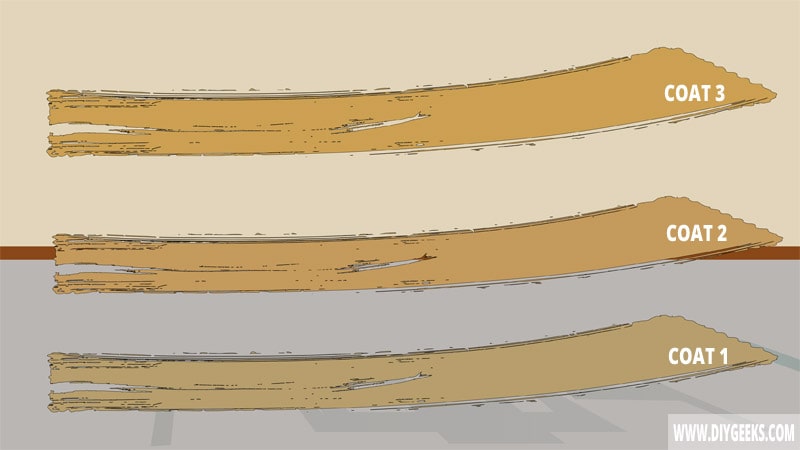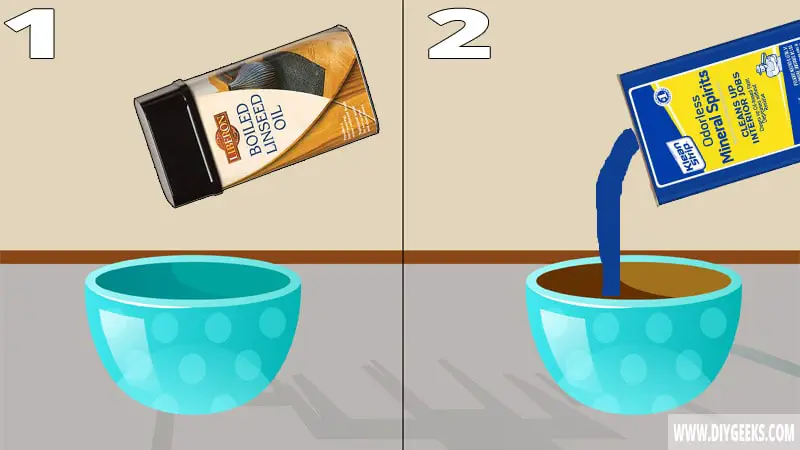Linseed oil is a wood finish that penetrates the wood pores and provides a protective layer that prevents water absorption.
Boiled linseed oil takes around 24 hours to dry between coats while Raw Linseed oil takes around 72 hours.
Factors that determine the drying time are room temperature, humidity levels, and coat viscosity.
How Long Does Linseed Oil Take To Dry Between Coats?

Boiled linseed oil takes around 24 hours to dry between coats, while raw linseed oil takes 72 hours. Boiled linseed oil dries fast as it’s formulated with oil thinners and drying agents.
The exact drying time is determined by the room temperature, humidity levels, and coat viscosity. For instance, linseed oil dries faster if the room temperature is higher than 50°F (10°C), the humidity levels are lower than 50%, and you apply thin coats.
If you re-coat Linseed oil too soon, the finish turns sticky, tacky, or may peel off because the new coating will prevent the evaporation process of the old coating, which increases the dry time.
Factors That Influence Linseed Oil Drying Time:
Factors that determine Linseed oil drying time are listed below.
- Room Temperature and Humidity Levels.
- Coat Viscosity.
- Linseed Oil Type.
- Application Method.
- Wiping the Excess
1. Room Temperature and Humidity Levels
Room temperature and humidity levels influence the Linseed oil drying time as they determine the solvent evaporation rate.
Linseed oil dries faster if the temperature is higher than 50°F (10°C) and the humidity is lower than 50% because the solvent (oil) evaporates faster.
Linseed oil takes longer to dry if the temperature is low and the humidity levels are high because the moist atmosphere delays the solvent (oil) evaporation rate.
2. Coat Viscosity
The finish drying time is determined by coat viscosity and the number of coats too. Linseed oil takes longer to dry if you apply too many thick coats as there’s more solvent (oil) to evaporate from the coating which takes longer.
Thin and fewer coats will dry faster as there’s less solvent (oils) on the surface to evaporate and the coating becomes hard (rigid) faster.
3. Linseed Oil Type
Each Linseed oil type has a different drying time because of its formula and additives. For instance, Boiled Linseed Oil dries faster than Raw Linseed Oil as it’s formulated with oil thinners and drying agents that help its coating to dry at a faster rate.
The Linseed oil brand determines the drying time too. Some brands add more drying agents to the formula or thin the wood oil more which makes it dry faster.
4. The Applicator Method
Linseed oil dries faster if you apply it with a paintbrush than if you apply it with a rag. Paintbrushes apply thinner coats while rags apply thicker coats.
5. Wiping the Excess
You must wipe excess Linseed oil 30 minutes after applying it. The finish will turn sticky, tacky, or may peel off if you don’t.
How to Make Linseed Oil Dry Faster?
To make Linseed Oil dry faster, do the following things.
- Thin Linseed Oil Before Applying.
- Increase Solvent Evaporation Rate.
1. Thin Linseed Oil Before Applying

Thinning Linseed oil before applying speeds up the finish dry time as thinner coats dry faster because there’s less solvent (oil) to evaporate.
To thin Linseed oil, use mineral spirits, turpentine, or white spirits.
The tools you need for this project are listed below.
- Mineral spirits or turpentine
- A paint mixer or stirring stick
- A clean paint bucket
- A pair of gloves
- A measuring cup (optional)
To thin Linseed oil before application, do the following things.
- Pour the linseed oil into a clean paint bucket.
- Use a thinning ratio of 2:1 (2 parts linseed oil, 1 part thinner).
- Pour the paint thinner (Mineral spirits, turpentine, or white spirits) into the bucket.
- Stir the mixture for at least 10 minutes.
- Use the thinned Linseed oil.
Tip: Always put the safety goggles on when working with thinners and solvents.
2. Increase Solvent Evaporation Rate

Linseed oil dries through solvent evaporation — the solvent (oil) must evaporate and the coating must become hard (rigid) for the finish to dry. The faster the solvent evaporates, the faster the coating dries.
To increase the solvent evaporation rate, do the following things.
- Opening all windows and doors, so there is better airflow.
- Use a hairdryer to speed up the drying time.
- Reduce room humidity with a dehumidifier.
- Turn on the fans in the room, so there is better air circulation around the coating.
- Use paint tents to prevent dust and mildew from settling on the wet coating.
- Wipe off the excess linseed oil a few minutes after its application.
Other tips to speed up Linseed oil drying time are listed below.
- Apply the wood oil only when the temperature and humidity are favorable.
- Don’t apply too many Linseed Oil coats.
- Always wipe off the excess after application.
- Never apply it on a wet surface.
- Choose boiled linseed oil over raw linseed oil.
- Thin it with mineral spirits before application.
- Provide proper ventilation in the room.
- Don’t use or clean the finish before it has cured – the solvent or cleaner can dissolve the linseed oil, making it wet again.
- Scuff between coats with fine-grit sandpaper so the next coat can adhere and dry properly.
- Always wipe and clean the surface before applying it. If the surface is dusty, the dust nibs will not allow the oil to stick, making the linseed oil dry slower than usual.
How Long Do Different Linseed Oil Types Take to Dry?
Refined Linseed Oil
Refined linseed oil takes around 12-24 hours to dry between coats and 3-5 days to cure (fully dry). It dries fast as it’s lighter, reinforced with drying agents, and has gone through a mechanical pressing that decreases its drying time.
Double-Boiled Linseed Oil
Double-boiled Linseed oil takes around 12 hours to dry between coats and 24 hours to cure. Double-boiled Linseed oil is heated twice and mixed with more drying agents that decrease its drying time.
Polymerized Linseed Oil
Polymerized Linseed oil takes around 24 hours to dry between coats and 5 days to cure.


